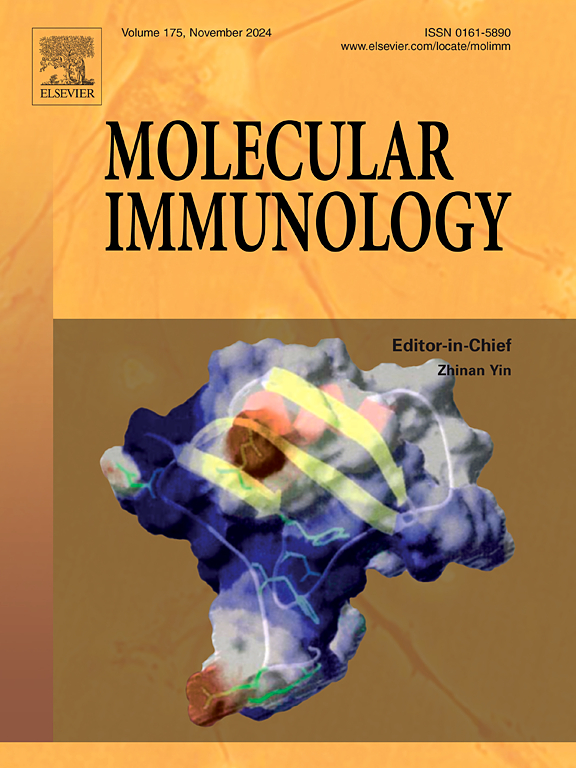通过抑制TLR4/NF-κB/COX-2通路和调节免疫检查点分子减轻脓毒症诱导的肺和肝损伤
IF 3.2
3区 医学
Q2 BIOCHEMISTRY & MOLECULAR BIOLOGY
引用次数: 0
摘要
脓毒症是一种常见的临床并发症,由于全身感染导致多器官损害,目前缺乏有效的治疗药物。THP (Tetrastigma hemsleyanum Diels et Gilg, TH)的多糖,简称THP,是从TH中提取的水溶性成分,具有抗炎和免疫调节的特性。本研究旨在探讨THP在脓毒症中的作用及其机制。结果表明,THP可降低盲肠结扎穿刺(CLP)小鼠外周血中性粒细胞,抑制血浆IL-6和MCP-1,从而改善全身炎症反应。THP可改善肺水肿,减轻肺和肝脏的组织病理学损伤,减少肺和肝脏中中性粒细胞和巨噬细胞的浸润,抑制两器官中TNF-α、IL-6、IL-1β和MCP-1的转录。此外,THP降低脓毒症小鼠脾脏的骨髓细胞、中性粒细胞、单核细胞和treg,同时增加T细胞、CD4+ T细胞和CD8+ T细胞,从而恢复免疫失衡。在机制上,THP通过抑制TLR4/NF-κB/COX-2通路的过度激活,降低脓毒症小鼠肺中PD-1、PD-L1、IDO1和肝脏中PD-1、PD-L1的表达来减轻脓毒症。总之,本研究为THP在脓毒症治疗中的潜在应用提供了理论支持。本文章由计算机程序翻译,如有差异,请以英文原文为准。
Alleviation of sepsis-induced lung and liver injury by polysaccharides from Tetrastigma hemsleyanum Diels et Gilg via suppression of TLR4/NF-κB/COX-2 pathway and modulation of immune checkpoint molecules
Sepsis, a common clinical complication, leads to multi-organ damage due to systemic infection and currently lacks effective therapeutic drugs. Polysaccharide derived from Tetrastigma hemsleyanum Diels et Gilg (TH), abbreviated as THP, is a water-soluble component extracted from TH, exhibiting anti-inflammatory and immunomodulatory properties. This study aims to investigate the effects and mechanisms of THP in sepsis. Results demonstrated that THP reduced neutrophils in the peripheral blood of mice established by cecal ligation and puncture (CLP), and inhibited IL-6 and MCP-1 in plasma, thereby improving systemic inflammation. THP ameliorated pulmonary edema, mitigated lung and liver histopathological injuries, reduced infiltration of neutrophils and macrophages in the lung and liver, and inhibited the TNF-α, IL-6, IL-1β, and MCP-1 transcription in both organs. Additionally, THP decreased myeloid cells, neutrophils, monocytes, and Tregs in the spleens of septic mice, while increasing T cells, CD4+ T cells, and CD8+ T cells, thereby restoring immune imbalance. Mechanistically, THP attenuated sepsis by inhibiting the overactivation of the TLR4/NF-κB/COX-2 pathway, and reducing PD-1, PD-L1, IDO1 in the lung, and PD-1, PD-L1 in the liver of septic mice. In conclusion, this study provides theoretical support for the potential application of THP in sepsis treatment.
求助全文
通过发布文献求助,成功后即可免费获取论文全文。
去求助
来源期刊

Molecular immunology
医学-免疫学
CiteScore
6.90
自引率
2.80%
发文量
324
审稿时长
50 days
期刊介绍:
Molecular Immunology publishes original articles, reviews and commentaries on all areas of immunology, with a particular focus on description of cellular, biochemical or genetic mechanisms underlying immunological phenomena. Studies on all model organisms, from invertebrates to humans, are suitable. Examples include, but are not restricted to:
Infection, autoimmunity, transplantation, immunodeficiencies, inflammation and tumor immunology
Mechanisms of induction, regulation and termination of innate and adaptive immunity
Intercellular communication, cooperation and regulation
Intracellular mechanisms of immunity (endocytosis, protein trafficking, pathogen recognition, antigen presentation, etc)
Mechanisms of action of the cells and molecules of the immune system
Structural analysis
Development of the immune system
Comparative immunology and evolution of the immune system
"Omics" studies and bioinformatics
Vaccines, biotechnology and therapeutic manipulation of the immune system (therapeutic antibodies, cytokines, cellular therapies, etc)
Technical developments.
 求助内容:
求助内容: 应助结果提醒方式:
应助结果提醒方式:


